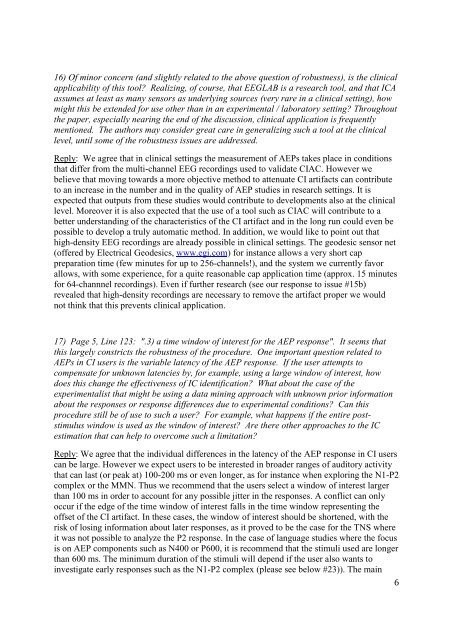Elsevier Editorial System(tm) for Hearing Research Manuscript Draft ...
Elsevier Editorial System(tm) for Hearing Research Manuscript Draft ...
Elsevier Editorial System(tm) for Hearing Research Manuscript Draft ...
Create successful ePaper yourself
Turn your PDF publications into a flip-book with our unique Google optimized e-Paper software.
16) Of minor concern (and slightly related to the above question of robustness), is the clinical<br />
applicability of this tool? Realizing, of course, that EEGLAB is a research tool, and that ICA<br />
assumes at least as many sensors as underlying sources (very rare in a clinical setting), how<br />
might this be extended <strong>for</strong> use other than in an experimental / laboratory setting? Throughout<br />
the paper, especially nearing the end of the discussion, clinical application is frequently<br />
mentioned. The authors may consider great care in generalizing such a tool at the clinical<br />
level, until some of the robustness issues are addressed.<br />
Reply: We agree that in clinical settings the measurement of AEPs takes place in conditions<br />
that differ from the multi-channel EEG recordings used to validate CIAC. However we<br />
believe that moving towards a more objective method to attenuate CI artifacts can contribute<br />
to an increase in the number and in the quality of AEP studies in research settings. It is<br />
expected that outputs from these studies would contribute to developments also at the clinical<br />
level. Moreover it is also expected that the use of a tool such as CIAC will contribute to a<br />
better understanding of the characteristics of the CI artifact and in the long run could even be<br />
possible to develop a truly automatic method. In addition, we would like to point out that<br />
high-density EEG recordings are already possible in clinical settings. The geodesic sensor net<br />
(offered by Electrical Geodesics, www.egi.com) <strong>for</strong> instance allows a very short cap<br />
preparation time (few minutes <strong>for</strong> up to 256-channels!), and the system we currently favor<br />
allows, with some experience, <strong>for</strong> a quite reasonable cap application time (approx. 15 minutes<br />
<strong>for</strong> 64-channnel recordings). Even if further research (see our response to issue #15b)<br />
revealed that high-density recordings are necessary to remove the artifact proper we would<br />
not think that this prevents clinical application.<br />
17) Page 5, Line 123: ".3) a time window of interest <strong>for</strong> the AEP response". It seems that<br />
this largely constricts the robustness of the procedure. One important question related to<br />
AEPs in CI users is the variable latency of the AEP response. If the user attempts to<br />
compensate <strong>for</strong> unknown latencies by, <strong>for</strong> example, using a large window of interest, how<br />
does this change the effectiveness of IC identification? What about the case of the<br />
experimentalist that might be using a data mining approach with unknown prior in<strong>for</strong>mation<br />
about the responses or response differences due to experimental conditions? Can this<br />
procedure still be of use to such a user? For example, what happens if the entire poststimulus<br />
window is used as the window of interest? Are there other approaches to the IC<br />
estimation that can help to overcome such a limitation?<br />
Reply: We agree that the individual differences in the latency of the AEP response in CI users<br />
can be large. However we expect users to be interested in broader ranges of auditory activity<br />
that can last (or peak at) 100-200 ms or even longer, as <strong>for</strong> instance when exploring the N1-P2<br />
complex or the MMN. Thus we recommend that the users select a window of interest larger<br />
than 100 ms in order to account <strong>for</strong> any possible jitter in the responses. A conflict can only<br />
occur if the edge of the time window of interest falls in the time window representing the<br />
offset of the CI artifact. In these cases, the window of interest should be shortened, with the<br />
risk of losing in<strong>for</strong>mation about later responses, as it proved to be the case <strong>for</strong> the TNS where<br />
it was not possible to analyze the P2 response. In the case of language studies where the focus<br />
is on AEP components such as N400 or P600, it is recommend that the stimuli used are longer<br />
than 600 ms. The minimum duration of the stimuli will depend if the user also wants to<br />
investigate early responses such as the N1-P2 complex (please see below #23)). The main<br />
6
















